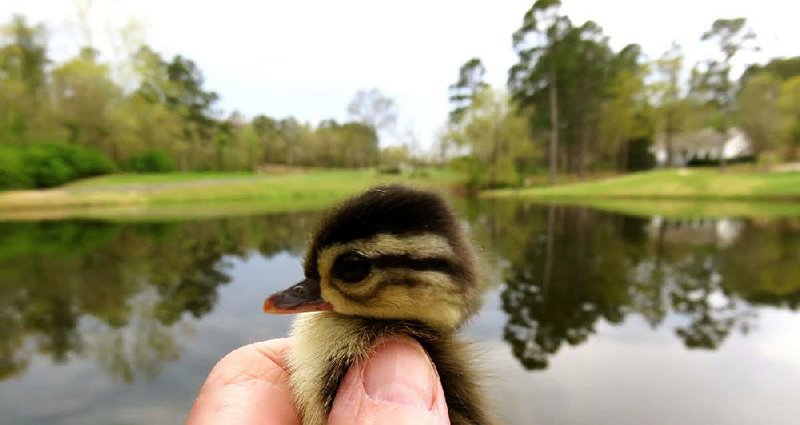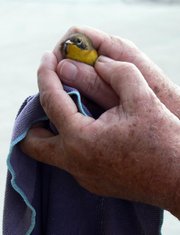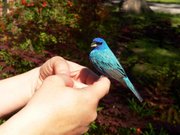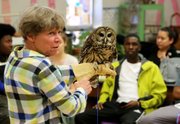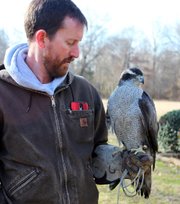"A bird in the hand is better than two in the bush," or so claims the proverb. An ancient Chinese variation of the same thought says, "Better one bird in the hand than a thousand flying in the cloud."
Such adages arose at a time when wild birds were an essential part of human diets, and having a bird in the hand was better because it meant that you would have something to eat, and having birds only in bushes meant that you might starve. Today, these proverbs convey that a sure thing is better than a gamble, a warning that greed threatens well being.
From the perspective of birds, however, being in a bush or among the clouds is far better than being held captive by men.
Wild birds thrive when they are in their natural habitat. Historically, if they found themselves in the hand of a person, they were likely in peril. That is a general rule for birds.
But birds in the hand are sometimes at an advantage -- depending upon whose hand it is, and the circumstances under which the bird came to be captured.
What follows are a few examples of instances where the birds were better off in the hands of people.
TINY WARBLER
The common yellow-throat is a tiny bird of the warbler family. I had not seen a specimen of this species close up in Arkansas until one flew inside the motel where I was staying in Blytheville. As I sat in the alcove adjacent to the lobby, eating my continental breakfast, the bird startled me and the other guests as it flittered and flew over the tables and dishes.
The motel staff made much ado, trying to shoo the bird out the door without success. I encouraged them to close the sliding door that separated the alcove from the rest of the lobby and turn out the lights, because the frightened yellow-throat was crashing against the windows.
As it flew toward the only remaining light -- a stripe at the bottom of a Venetian blind -- I was able to catch it using a tablecloth as a net. Then, holding the bird in my cupped hands, I took it outdoors to release. The bird flew into the bushes along a nearby drainage ditch.
It was better off in those bushes than in my hand, but it was better off in my hand than thrashing itself against the plate glass windows of the motel.
One time a bird struck a window outside the house of my neighbor, Holly Benham of Scott. She had heard the thump and went outdoors to find a male indigo bunting shaking and flopping on the ground.
The injured bird had also caught the attention of a domestic cat, which was crouched as if to pounce.
Benham came to the rescue by picking up the bird and allowing it to perch on her hand and by making the cat skedaddle. Then she placed the strikingly beautiful bird high in an azalea bush, and stayed nearby for about 20 minutes to keep the cat at bay. Finally the revived bird took flight to join others in a tall pecan tree.
In this instance, the bunting had been best off as it flew about the Benhams' yard -- before it crashed into the highly reflective windows. It was in deep peril as the crouching cat stalked it, but better off in the hands of its rescuer. It was safe in the azalea as long as Benham watched.
In the long run, it might or might not have recovered from the shock of crashing into the window. But by being in Benham's hand, even briefly, it had a chance to resume a normal bird life.
MAKE WAY FOR DUCKLINGS
Beverly Salisbury of Hot Springs Village counted from her yard as eight tiny ducklings tumbled out of the wood duck nesting box at the edge of a pond on Balboa Golf Course.
She looked forward to seeing the sight each year.
After the octet of ducklings had joined their mother on the surface of the water, Salisbury walked to the edge of her property to get a closer look and to photograph the family of ducks. Standing there, she heard scratching and thumping inside the man-made nest box that she presumed had been recently vacated.
Lifting the lid, she saw that a single duckling remained on the floor of the nest box. The eight that had exited earlier could stand on one another's heads to reach the round hole.
That hole was probably cut a bit too high above the floor for a single duckling to reach. Ladder-like grooves had not been cut on the front wall for the little guy to grasp with its toenails and reach the opening.
This duckling had been left behind, and would have perished had not Salisbury reached in to lift it from the nest. Salisbury held it in her hand long enough to take a photo, and then she placed it in the water where it soon paddled to join its mother, brothers and sisters.
SAW-WHET OWL PROJECT
At age 15, Mitchell Pruitt worked as a volunteer at Crowley's Ridge Nature Center near Jonesboro. As part of his duties, he helped with the care of an injured eastern screech owl that had been blinded and so would not survive in the wild. He was allowed to hold the bird to show it to the visitors.
Holding that bird in his hand may have been the spark that kindled in Pruitt's intense interest in small owls. Today, as a graduate student studying ornithology at the University of Arkansas, Fayetteville, he researches the northern saw-whet owl.
Saw-whets once were believed to be extremely rare in Arkansas, but Pruitt's research suggests that they are much more abundant than thought in areas with suitable habitat. By setting up nets at night to capture these nocturnal birds, fitting them with radio transmitters and tracking them electronically, Pruitt, his professors and colleagues have opened a new line of inquiry into Arkansas birds.
FALCON'S ROOST
Some birds end up in the hands of people regularly.
Falconers hold birds of prey in their hand. Researchers who band hummingbirds to study migration take them in hand, as do game and fish authorities who try to balance populations and set hunting limits.
Environmentalists who clean oil-caked birds around oil spills and wildlife rehabilitators who care for injured birds must do so in a hands-on way.
At park interpretation programs, licensed educators handle wild birds as they teach young people to respect and appreciate the natural world.
HAND TAMING?
Another way a wild bird might end up in the hand of a person is if that person could coax the bird to do so of its own free will.
Domestic fowl such as chickens, pigeons, parrots and turkeys can be easily taught to eat from human hands, but it takes more time and patience to get a wild bird to do so. I have observed people getting chickadees, hummingbirds and cardinals to eat food from their hand.
Once I saw a man who had taught a titmouse to land on his head each time he walked out the backdoor, and another man who fed peanuts to a jay with his fingers.
Writing in the Farmer's Almanac, Harriet McEwen Kimball makes these "Rules for Hand-Taming Wild Birds":
As you approach the bird speak continually.
Never hold out your hand to a bird unless it contains food.
Never swallow while a bird is in your hand.
If you see signs of fear in the bird, hold your breath.
Never close your hand on a wild bird.
If a bird leaves while you are taming it, do not follow it.
Do not overload your feeder while taming birds.
Do not allow even your best friend near your tamed bird unless you are with him.
Do not be discouraged if your first attempts at hand taming are unsuccessful.
Taming wild birds to come to feed from the hand is usually done by first getting them to come to a feeder where there is human activity about. The entire process is described in the book Hand-Taming Wild Birds at the Feeder by Alfred G. Martin.
ON THE OTHER HAND ...
At the risk of sounding like a disclaimer on a prescription drug ad, some hazards can arise when humans decide to hand-feed wild birds.
I discussed these concerns with Jennifer R. Ballard, the Arkansas Game and Fish Commission state wildlife veterinarian.
"In general, I would not recommend encouraging any wildlife, including birds, to feed directly from the hands of humans," Ballard said. "It encourages animals to become acclimated to humans and to associate them with food, which can alter their natural behaviors.
"If animals begin to expect food from humans they may become aggressive or get injured attempting to approach people who do not expect it ... animals that are hand-fed in parks often receive foods, like bread and chips, that are very unhealthy for them."
With respect to human risks, Ballard said diseases can be transmitted to people from birds during hand-feeding.
"It's hard to say if it's any greater a risk than handling pets because it really depends on the species and disease of interest. Some diseases that could theoretically spread from wild birds to humans include E. coli, salmonella and Chlamydia psittaci.
"Handwashing is an excellent way to prevent the transmission of most of these diseases, but exposure to aerosol pathogens could still occur."
Recent research at the University of Georgia at Athens has attempted to learn whether urban wildlife with increased exposure to humans can also experience greater stress. One study conducted in Florida linked the hand-feeding of white ibis to salmonella in the birds and the humans. See arkansasonline.com/22618/ibis.
Ballard said such research suggests that artificial feeding can inadvertently spread diseases among wild animals by increasing their contact with one another.
"This is the reason it's so very important to clean and disinfect bird feeders regularly," she said.
Jerry Butler writes about Arkansas birds and people who enjoy them. He welcomes your stories and comments at [email protected].
ActiveStyle on 02/26/2018

